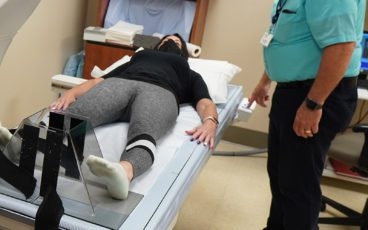Recently, a scientific discovery has been made that is believed to have huge implications for regenerative medicine. The scientists involved have uncovered a new bone-forming growth factor, which may reverse the bone loss associated with osteoporosis.
What is Osteoporosis?
Meaning “porous bone,” osteoporosis is a bone disease that occurs when your body loses too much bone, produces too little bone, or a combination of the two. Because of this, your bones lose density or mass and contain abnormal tissue structure. Depending on the severity of your osteoporosis, your bones may be more susceptible to break from a fall, or in serious cases, from sneezing or minor bumps.
Who is at Risk for Developing Osteoporosis?
According to the National Osteoporosis Foundation, about 54 million people in the United States suffer from either osteoporosis or low bone mass. This disease can affect anyone, but it is more common in postmenopausal women because of the sudden decrease in protective estrogen levels. In addition, women have less bone mass compared to men, and generally take in less calcium.
Your risk for osteoporosis increases with age beginning in your mid-30s. If this disease runs in your family, especially if a parent or sibling suffers from it, you have a higher risk of developing osteoporosis.
Treatments for Osteoporosis
Although osteoporosis cannot be completely reversed, there are different steps you can take to help manage his disease. Common treatment options include treating and preventing bone fractures, taking medication to help strengthen your bones, and estrogen therapy to help maintain bone density. These options can help reduce a patient’s rate of bone loss, but none of them promote new bone growth. Teriparatide (PTH) is a treatment option that promotes new bone growth, but use of it is limited to 2 years due to a risk of developing bone cancer.
The researchers have made a new discovery that may revolutionize the treatment options for osteoporosis. In their study, they have discovered a new bone-forming growth factor Osteolectin, or Clec11a. The scientists are believed to be the first to demonstrate that Osteolectin promotes new bone formation from skeletal stem cells in bone marrow.
Osteolectin Significantly Increased Bone Volume and Reversed Bone Loss
In the study, mice were used to conduct research. The researchers discovered that when Osteolectin was deleted in adult mice, there was a rapid acceleration in bone loss. The mice also showed symptoms of osteoporosis, including diminished bone strength and delayed healing of fractures.
To find out if it is possible for Osteolectin to reverse bone loss after osteoporosis had developed, the researchers used two groups of mice that had their ovaries removed to mimic osteoporosis that develops in postmenopausal women. The researchers provided the one group of mice with a daily injection of PTH and the other group of mice with a daily injection of Osteolectin.
When compared to the group with PTH, which is an agent already proven to promote bone formation, Osteolectin showed similar results. Both treatments successfully reversed the bone loss that occurred as a result of ovary removal. Compared to the untreated mice, bone volume had significantly increased in both the PTH treated and the Osteolectin treated mice. Because of these findings, further experiments can be conducted to test Osteolectin’s therapeutic potential.
Osteoporosis Screening in Illinois
If you’re looking to have an osteoporosis screening performed in Illinois, trust the expert physicians at Illinois Bone & Joint Institute. As leaders in orthopedics, we provide comprehensive integrated care to those who are suffering from osteoporosis and other chronic conditions. For more information on how we can help you, be sure to visit an Illinois location nearest you or contact us today.
*This content is for information only and is not intended to replace the diagnosis, treatment, or medical advice from your treating healthcare professionals. The content does not provide medical advice, does not constitute the practice of medicine or other healthcare professional services, and does not create a doctor-patient relationship. You should not rely on this information as a substitute, nor does it replace professional medical advice, diagnosis, or treatment. If you have concerns or questions, seek the advice of your healthcare professionals. If you think you may have a medical emergency, call your doctor or 911 immediately. Do not rely on electronic communications or communicate through this website for immediate, urgent medical needs. This website is not designed to facilitate medical emergencies. The use of the information is at the reader’s own risk. The links are provided for information and convenience only. We cannot accept responsibility for the sites linked or the information found here. A link does not imply an endorsement of a site.




